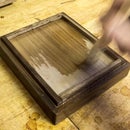Introduction: Removing Black Stains in Wood Furniture With Oxalic Acid
Iron oxide stains in wood are usually dark spots caused by prolonged exposure to water and / or metal. The iron oxide reacts with the tannins in the wood and stains it black. Wood can intentionally be stained black in the same way, and that's called Ebonizing.
Along the edge of my desk I kept a rusty metal ruler, and sometimes I would over-water the plant on the desk and the water would pool up under the ruler. In a short time this lead to black stains all along the edge of the desk.
I've seen some amazing results from furniture restorers using oxalic acid to remove such stains, but I couldn't find it locally and never got around to ordering it online.
One day I came across a How-To by Thomas Penrose and realized that I already had oxalic acid in the form of Bar Keeper's Friend. A big thanks to him for the write up. I'm going to relay those basic steps and add some tips of my own.
Materials and Supplies:
- Bar Keeper's Friend or similar powdered metal polish containing Oxalic Acid (Red Bear, etc.)
- Water
- Paper Towels
- Chip Brush (optional)
- Plastic Paint Scraper
- Stiff Nylon Brush (optional)
Step 1: Assess the Stain
If the stain is dark, almost black, chances are it's from water exposure, but it could also be from ink etc.
If the stain is dark red, it's probably from wine or food or anything else.
This method will only work to remove dark iron oxide stains. It won't hurt to try, but it'll probably be more effective to bleach / sand / refinish other types of stains.
If the wood has a polyurethane finish or other surface coating and you see a stain, it's stained underneath, and that coating needs to be removed first.
If the piece has an oil finish or if it's raw wood, you don't need to do anything to prep the surface.
Step 2: Make a Paste With Bar Keeper's Friend and Water
Add some water to Bar Keeper's Friend until you have a consistency that you can work with.
The ratios aren't important, but you don't want it to be too wet. Excess water is just going to raise the grain. All you need the paste to do is sit on the surface of the wood. You don't need it to soak in.
Step 3: Wipe It On
Always test on an inconspicuous area first!
- There shouldn't be any negative effects, but it's good to find out on a small area instead of the whole surface if there is.
For the first application, target the stains.
Wipe or brush it on and then wait until it dries (15-30+ minutes).
As it's drying, you should see the white paste turn slightly yellow. This is good.
Step 4: Scrape It Off
I scraped the dried mixture off and vacuumed it up rather than wetting the surface and wasting paper towels.
After the first application you should already see a huge difference. If not, then this method probably isn't going to work on the stain.
Step 5: Second, Third, Fourth Applications
Mix up another batch and apply it the same way you did before.
When the stains are mostly gone, you'll notice that the area you cleaned will be lighter than the surrounding areas.
For the next application apply the mixture to the entire surface of the piece to help blend it together.
Step 6: The End Result
I only needed 3 applications to get the stains to a point where I didn't mind anymore. Further applications will remove the stain completely. My plan is to refinish the top of the desk at some point, first by applying oxalic acid to any other stains, and then rubbing with #0000 steel wool and oil to clean the dirt while leaving most of the patina that's built up since I've owned it.
Final Tips:
- Because Oak has a very open grain, a lot of the mixture will be stuck in the grain of the wood. I used a stiff nylon brush in a circular motion to remove it. This probably isn't necessary on other species of wood.
- If your refinishing process involves steel wool, be really careful to remove all of the metal shavings from the surface, especially with Oak. It's recommended to use brass wool or synthetic wool to avoid this. When the metal particles get wet in the future, it will just start the whole staining process over again and you'll have to redo it. In practice steel wool is fine, just make sure to blow the piece off with compressed air and buff it with a microfiber to remove all of the shavings.
- When sanding, don't sand too deep. As you cut further down into the surface you might expose more of the stain, and then you'll have to reapply oxalic acid all over again.

Runner Up in the
Home Remedies Challenge 2016













